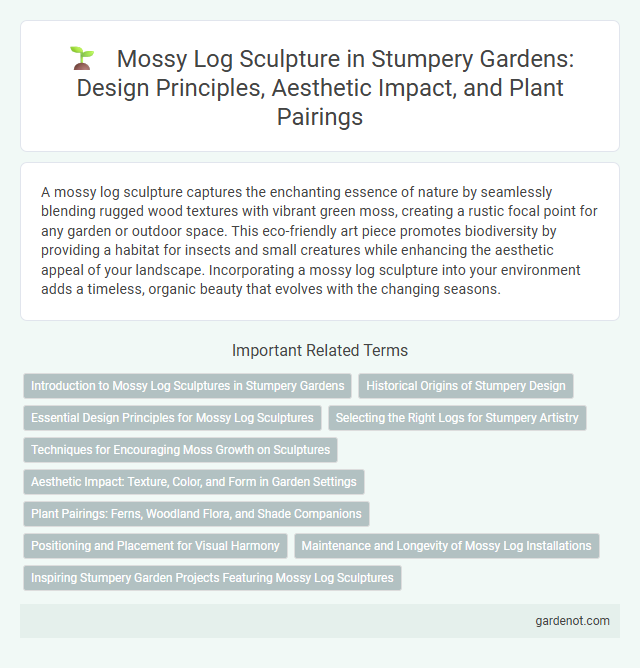A mossy log sculpture captures the enchanting essence of nature by seamlessly blending rugged wood textures with vibrant green moss, creating a rustic focal point for any garden or outdoor space. This eco-friendly art piece promotes biodiversity by providing a habitat for insects and small creatures while enhancing the aesthetic appeal of your landscape. Incorporating a mossy log sculpture into your environment adds a timeless, organic beauty that evolves with the changing seasons.
Introduction to Mossy Log Sculptures in Stumpery Gardens
Mossy log sculptures in stumpery gardens showcase natural artistry by transforming decayed wood into living, textured works of art, blending seamlessly with ferns, mosses, and shade-loving plants. These sculptures emphasize biodiversity by providing habitats for insects and fungi, enhancing the ecological value of garden spaces. Crafting mossy log sculptures involves careful selection of aged logs and promoting moss growth through moisture and shade, creating enduring garden focal points.
Historical Origins of Stumpery Design
Mossy log sculptures in stumpery design originate from 19th-century Victorian garden architecture, where botanists and gardeners created naturalistic displays using fallen tree trunks and vibrant mosses. These designs emphasize the ecological beauty of decaying wood, promoting biodiversity by providing habitats for fungi, insects, and mosses. The historical practice reflects a fusion of artistry and nature conservation, celebrating woodland aesthetics and organic textures within cultivated garden spaces.
Essential Design Principles for Mossy Log Sculptures
Mossy log sculptures thrive on the principles of natural harmony, balancing texture and form to evoke woodland aesthetics. Essential design elements include selecting logs with varied contours that complement the lush, velvety moss, enhancing contrast and depth. Strategic placement encourages organic growth patterns, integrating epiphytic plants to maintain ecological authenticity while ensuring visual appeal.
Selecting the Right Logs for Stumpery Artistry
Selecting the right logs for mossy log sculptures in stumpery artistry involves choosing wood with natural textures that encourage moss growth, such as oak, elm, or fir. Logs should be positioned in damp, shaded environments to maintain moisture and support vibrant moss proliferation. Preferably, select fallen branches or decayed logs that blend seamlessly into woodland settings, enhancing both ecological value and aesthetic appeal.
Techniques for Encouraging Moss Growth on Sculptures
Techniques for encouraging moss growth on mossy log sculptures include maintaining consistent moisture by misting the surface regularly and situating the sculpture in shaded, humid environments to mimic natural moss habitats. Applying a moss slurry, composed of blended moss, buttermilk, or yogurt, directly onto the log enhances moss spore adhesion and accelerates colonization. Ensuring the log has a rough, porous texture promotes moss attachment, while avoiding direct sunlight prevents drying and supports lush, green moss development.
Aesthetic Impact: Texture, Color, and Form in Garden Settings
Mossy log sculptures enhance garden aesthetics through rich texture, vibrant green hues, and natural organic forms that blend seamlessly with surrounding foliage. Their tactile surfaces invite closer inspection, creating a sense of depth and tranquility within outdoor spaces. These elements collectively elevate the visual interest and harmony of garden environments, emphasizing the beauty of natural decay and renewal.
Plant Pairings: Ferns, Woodland Flora, and Shade Companions
Mossy log sculptures thrive when paired with ferns such as Athyrium and Polystichum, which thrive in damp, shaded environments mimicking natural woodland floors. Complementary shade companions like wild violets and hostas enhance texture and color contrast, creating an immersive forest scene. Integrating woodland flora such as wood anemones and trilliums promotes biodiversity and elevates the ecological harmony of the stumpery display.
Positioning and Placement for Visual Harmony
Positioning a mossy log sculpture in a shaded, moist area enhances its natural texture and vibrant green hues, promoting visual harmony within a woodland garden. Placing it near ferns or hostas creates a seamless transition between the sculpture and surrounding flora, emphasizing organic unity. Elevating the log slightly on a bed of soft moss ensures proper drainage and accentuates the contrasting textures for an eye-catching focal point.
Maintenance and Longevity of Mossy Log Installations
Regular misting and ensuring consistent shade are critical for maintaining vibrant moss coverage on stumpery mossy log sculptures. Applying a light acidic spray such as diluted vinegar helps prevent unwanted algae or mold growth, preserving the sculpture's natural aesthetics. Properly sourced and aged wood logs enhance durability, resisting decay and supporting moss longevity over multiple seasons.
Inspiring Stumpery Garden Projects Featuring Mossy Log Sculptures
Mossy log sculptures serve as captivating focal points in stumpery garden projects, blending natural decay with artistic creativity. These organic installations enhance biodiversity by providing habitats for moss, fungi, and insects, contributing to a thriving woodland ecosystem. Incorporating weathered logs drenched in vibrant moss textures elevates garden aesthetics while promoting sustainable gardening practices.
Mossy log sculpture Infographic

 gardenot.com
gardenot.com